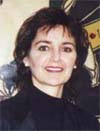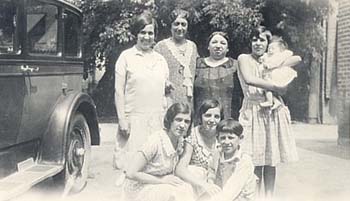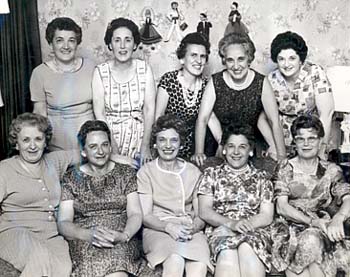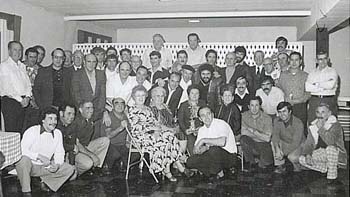American Basque Fraternity Auxiliary
 By
the 1920s in Boise, Idaho, there were two private Basque insurance
societies established for men only, which would pay a death benefit,
hospital care, and repatriation costs for those indigent and needing
to return to the Basque Country. Escolástica Arriandiaga
Ondarza saw the need for a Basque women’s club, similar to the
Basque men’s La Sociedad de Socorros Mutuos (1908),
or Mutual Aid Society, which had approximately 200 members, and
La Fraternidad Vasca Americana (1928), or American Basque
Fraternity, and helped she form the American Basque Fraternity
Auxiliary group for women in 1930. Escolástica Ondarza
served as its President for thirteen years. The women created
their own ikurriña, Basque flag, with materials
and supplies ordered from Bilbao, Bizkaia, and upon their arrival,
Antonia Ysursa began her two-year sewing project in 1930. She
hand-sewed the flag, made of silk, and hand embroidered a Tree
of Gernika and a gold fringe around the edges. The flag of the
American Basque Fraternity Auxiliary was even blessed by a Catholic
missionary from Denver on August 15, 1934. Exactly forty-one years,
later Escolástica Ondarza and Asunción Camporredondo
Ysursa represented the Auxiliary members when they presented the
flag to Arthur Hart, Director of the Idaho State Historical Society. By
the 1920s in Boise, Idaho, there were two private Basque insurance
societies established for men only, which would pay a death benefit,
hospital care, and repatriation costs for those indigent and needing
to return to the Basque Country. Escolástica Arriandiaga
Ondarza saw the need for a Basque women’s club, similar to the
Basque men’s La Sociedad de Socorros Mutuos (1908),
or Mutual Aid Society, which had approximately 200 members, and
La Fraternidad Vasca Americana (1928), or American Basque
Fraternity, and helped she form the American Basque Fraternity
Auxiliary group for women in 1930. Escolástica Ondarza
served as its President for thirteen years. The women created
their own ikurriña, Basque flag, with materials
and supplies ordered from Bilbao, Bizkaia, and upon their arrival,
Antonia Ysursa began her two-year sewing project in 1930. She
hand-sewed the flag, made of silk, and hand embroidered a Tree
of Gernika and a gold fringe around the edges. The flag of the
American Basque Fraternity Auxiliary was even blessed by a Catholic
missionary from Denver on August 15, 1934. Exactly forty-one years,
later Escolástica Ondarza and Asunción Camporredondo
Ysursa represented the Auxiliary members when they presented the
flag to Arthur Hart, Director of the Idaho State Historical Society.
The Men’s Mutual
Aid Society, Socorros Mutuos, was a private insurance fund
created in 1908 for medical emergencies, funeral costs for those
unable to afford the expenses, and for long-term disabilities.
La Organización Independiente Sociale, the Social
Independent Organization, which was formed in 1933, was more the
women’s counterpart of the Socorros Mutuos. Their annual
fee for benefits was $2.00. According to its 2002 Treasurer, Audrey
Arregui Groff, "It remains strictly an insurance fund to
which members now pay a yearly fee of $15.00, and there is a death
benefit of $750.00. We have 147 members, all Basque or married
to a Basque, that pay their annual fee. We used to have card parties,
rummage sales, and dances to raise money for the fund to make
sure we had enough to pay these funeral benefits, but we haven’t
needed to raise money anymore. The dues are sufficient to pay
the $750.00 benefit. We don’t have any legal contracts or anything.
We have a handshake, and our word. That’s it."
 |
| From
top left: Marie Yribar, a friend, Juana Arriola Uberuaga,
Petra Uberuaga, Juanita, Marie Uberuaga, and Joe Uberuaga
(Boise, Idaho -- early 1920s) |
The men’s La Fraternidad
Vasca Americana, Basque American Fraternity, formed in 1928,
gave financial assistance but also included different areas of
promoting United States citizenship, learning English, and promoting
Americanization of Basques. The women’s American Basque Fraternity
Auxiliary was formed in 1930 with the same goals of learning about
the United States, becoming and being good citizens, and promoting
learning English. Joe M. Uberuaga remembers his mother, Juana
Arriola Uberuaga, preparing for the Basque Fraternity Auxiliary
meetings every month or so. "It was a chance for the women
to get out of the house and have some fun. I know they gossiped
about everyone and everything because Mother always had lots of
stories to tell the next day. But they also helped solve each
other’s problems of getting around in the community. You know,
getting to the dentist, making bank deposits, learning how the
schools functioned in the United States- those kinds of things."
However, no one seems to remember anyone practicing any English
at these meetings.
The Basque
Girls’ Club
The "Basque
Girls’ Club", "Basque Girls’ Sewing Club", and
the "Basque Girls’ Knitting Club" are all actually the
same group of women. Formed in 1936 with mostly second generation
Basque members, these women wanted to create their own social
network separate from that of their mothers’. This collection
of friends, led by President Sue Letemendi, met every Tuesday
night in the 1930s and 1940s and organized an annual Halloween
costume party and an annual dinner and dance for members and their
dates. They arranged dance classes and parties at Hyde Park for
the Basque children of the community, and held competitions to
carry buckets of water on their heads, and taught the children
how to play the spoons. The Basque Girls’ Club also had dinners
and dances where the general public was invited and Jimmy Jausoro
and his Orchestra entertained. Jim was actually the only male
ever granted membership.
 |
| The
charter members of the Basque Girls Knitting Club are, from
top left, Maria Alegria, Rose Murelaga, Juanita Yribar, Vicki
Urresti, Tomasa Erquiaga, Juanita "Jay" Hormaechea,
Marie Arregui, Sue Anduiza, Petra Cengotita, and Espe Alegria
(Boise, Idaho 1962) |
In the 1950s, the
women volunteers catered dinners at the Basque Center to raise
money for the building construction. The Basque Girls’ Club originated
the Euzkaldunak Incorporated Basque Center November Mortzilla
Dinner and Carnival Bazaar, where all enjoy Basque cuisine and
Basque foods are sold to the public. Children play various games
and make art projects at the carnival and adults play BINGO for
hours, hoping to win a prize while raising money for the Euzkaldunak,
Inc. Prizes are donated by local businesses and Euzkaldunak members
make additional items. There is nothing distinctly "Basque"
about the event anymore except for the cuisine and mortzillak,
blood sausages, and the ethnically Basque customers.
At one time, there
were thirty-three members in this women’s club, but in 2002, the
group has eight active members still living who continue to meet
monthly. These Basque women have volunteered in community projects
such as the Red Cross bandage rolling effort for WWII. They also
sent correspondence to United States military troops during World
War II to help lift spirits. Juanita Uberuaga Hormaechea kept
a copy of a letter she sent to a United States military squadron
explaining who she and her club were, and how they were "so
very very proud to be Basque in America where all individuals
are respected. You are all in our prayers." The Basque Girls’
Club participated in fund drives for the Lung Association, and
assisted at the Nampa Idaho State School and Hospital with volunteers.
After the 1970s, members’ activities turned to mostly social events
such as day outings to Idaho City, picnics and barbecues, dinners
and birthdays parties. Mary Larrondo joined the Basque Girl’s
Club in the 1950s after she moved to Meridian from Glenns Ferry.
"Oh, we’ve had a great time over the years. You know there
are only a few of us still alive but boy did we have a good time.
We volunteered for many activities and put on some fantastic parties.
Jay’s scrapbooks have pictures of us at our Halloween parties.
Maybe that’s not such a good thing. We were crazy!" Indeed,
Juanita Hormaechea’s collection of more than one hundred photo
albums are overflowing with evidence of their friendship, sisterhood,
humor, and pride in culture and Basque identity.
Aiztan Artean
The next generation
women’s club, The Aiztan Artean, Among Sisters, is composed
of younger Basque women who volunteer to support Basque fundraisers,
events, groups, and activities in the Boise area. The club commenced
meeting in 1972 and is a social-service group of women who are
of Basque heritage or are married to Basques. The founding young
Basque women pledged to support the Basque Center activities and
to further activities for younger members of the Basque community.
They are the next generation of females after the Basque Girl’s
Club. Gloria Subisarreta Miller, Toni Murelaga Achabal, Clarine
Anchustegui Villeneuve, Liz Dinse, Leandra Jayo Parker, Julie
Egurrola Bilbao, and Chris Bideganeta LaRocco accepted leadership
roles for the initial year and hosted an informal reception at
the Basque Center in March 1973 to welcome and encourage additional
women to join.
 |
| At
the Basque Center (Boise, Idaho 1978) |
The Aiztan Artean
club members sponsored Basque cuisine cooking classes at the Euzkaldunak
Basque Center during the months of March, April, and May of 1975.
The fifteen to twenty women at each session learned the intricacies
of food preparation from Basque Center cook Sabina Arteta Oleaga.
Each week a different menu was prepared which included codfish,
tripe, ink fish, brazo de gitano cake, rice pudding, and
flan custard. Sabina Oleaga would demonstrate each of the steps
of food preparation and cooking, and then the participants enjoyed
the presentation and the tasting afterwards.
Today, the more than
forty members host Basque Center dinners, a Mothers’ Day Luncheon,
and monthly meetings at private homes. They also organize and
host a Girls’ Night Out, and a Sweethearts’ Dinner. The Aiztan
Artean help with a children’s carnival that is a part of the
November Mortzillak Dinner and Carnival Bazaar. Basque youth have
their faces painted with artistic figures, they decorate cookies,
which they then can eat on the spot or take home. They participate
in carnival games of "fishing" for prizes behind a screen,
and "spin the wheel" for prizes- all organized by the
women of the Aiztan Artean.
|
Bibliography of sources
Totoricagüena,
Gloria. Boise Basques: Dreamers and Doers.
Serie URAZANDI. Vitoria-Gasteiz: Eusko Jaurlaritza.
2003. |
|
Gloria Totoricagüena Egurrola,
Center for Basque Studies. University of Nevada Reno
Photos: Copyright © 2001 Basque Museum & Cultural Center,
Boise, Idaho USA All rights reserved. Center for Basque Studies,
Reno, Nevada USA
http://www.basquemuseum.com/oralhistory/index.htm
|

